David J. Howe's Blog, page 23
June 5, 2015
Review: Society (1989)
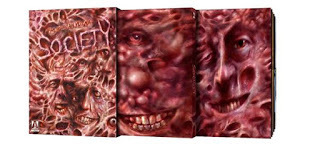
Unlike the previous 'horror' film I reviewed here, Society is a bona fide horror classic which is an absolute pleasure to watch!
For whatever reasons, I'd never seen Society before. I'd heard of it, and seen photographs from it, but never seen the actual film, so it's a double treat to put that right. As a horror film, it ticks all the right boxes and presents a great little small-town mystery. In a way, there are echoes of Dan O'Bannon's Dead and Buried here, with something rotten being hidden in the heart of a small town, where everyone is in on the 'joke' except for the hapless outsider who is trying to figure it all out and to escape with their life at the end.
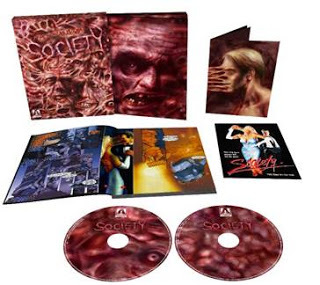
With Society, though, the secret is part and parcel of the town's very being, and the 'outsider' is actually the son of the leading family, the Whitneys. He's just not really part of the family, being adopted, and thus his Mother, Father and Sister's behaviour seems mysterious at first, and then just darn strange as we peel back the layers to reveal what is hidden beneath.
Brian Yuzna does a great job of directing, presenting things as almost-normal to start with, but then becoming increasingly strange as deaths occur, and young Billy starts to discover things about his family which he wished he hadn't known ... but then the facts change, a tape with incriminating dialogue on is different when listened to again ... and Billy is left out on a limb. There is an effective paranoia at work here which is compounded and enhanced by small elements, like his friend's death and the face of the corpse crumbling in the church (is he really dead?) He finds another friend dead, but when he goes to get the authorities, there is no body when he returns ... is Billy going mad?

All this is building to a climactic ending: his sister's coming out party, where all the town turns up to celebrate. Billy also finds himself there, captured, and told that you have to be born into society to be a part of it ... upon which, his supposedly dead friend is also served up, and the townspeople fall on him, morphing and mutating into something totally inhuman as 'the shunt' begins - a pseudo sexual orgy of slime and blood and twisted flesh ...
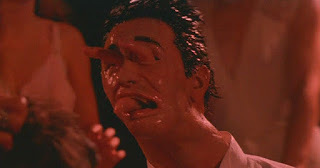
Of course for the horror fan, this is simply awesome, and seeing the name Screaming Mad George on the credits for effects should be enough to let most fans know what sort of thing to expect. George is a master of the twisted body horror, and the film does not disappoint, with visuals ranging from the memorable 'butt face' to a massive hand where a head should be, to bodies being turned completely inside out ... it's an incredible visual array of horror, perhaps only matched by the work of Rob Bottin in John Carpenter's 1982 film The Thing. (It's interesting that George cites both Landis' American Werewolf in London (1981, effects by Rick Baker) and Joe Dante's The Howling (1981, effects by Rob Bottin) as films which influenced him.)
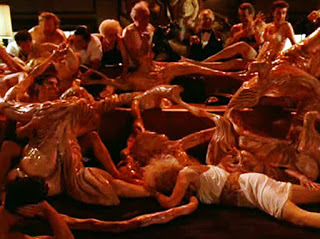 The action comes thick and fast at the end and our hero Billy escapes with the rather lovely Clarissa, but she of course might be part of the strange Society herself ... but in great eighties fashion, the film just ends when they escape, so we never find out what happens.
The action comes thick and fast at the end and our hero Billy escapes with the rather lovely Clarissa, but she of course might be part of the strange Society herself ... but in great eighties fashion, the film just ends when they escape, so we never find out what happens.Overall it's a great slice of eighties paranoia, infused with a horror sensibility, and some original and still startling effects. Arrow have provided a smashing set of extras as well - including a discussion with Screaming Mad George about the effects, interviews with cast and crew as well as much more besides. A great package, and highly recommended.
Special Features
·
Newly remastered 2K digital transfer of the film, approved by director Brian Yuzna
·
High Definition Blu-ray (1080p) and Standard Definition DVD presentation
·
Original Stereo 2.0 audio (uncompressed PCM on the Blu-ray)
·
Optional English SDH subtitles for the deaf and hard of hearing
·
Brand new audio commentary by Yuzna
·
Governor of Society – a brand new interview with Yuzna
·
The Masters of the
Hunt – a brand new featurette including interviews with stars Billy
Warlock, Devin DeVasquez, Ben Meyerson and Tim Bartell
·
The Champion of the Shunt – new featurette with FX artists Screaming Mad George, David Grasso and Nick Benson
·
2014 Q&A with Yuzna, recorded at Celluloid Screams Festival
·
Brian Yuzna in conversation backstage at the Society world premiere
·
‘Persecution Mania’ – Screaming Mad George music video
·
Limited Edition Digipak packaging featuring newly-commissioned artwork by Nick Percival
·
Collector’s booklet featuring new writing on the film by critic Alan Jones, illustrated with original archive stills and posters
·
Society: Party Animal [Limited Edition Exclusive] – the official comic sequel to
Society, reproduced in its entirety in a perfect-bound book
Published on June 05, 2015 02:51
June 3, 2015
Review: The Strange Case of Dr Jekyll and Miss Osbourne (1981)
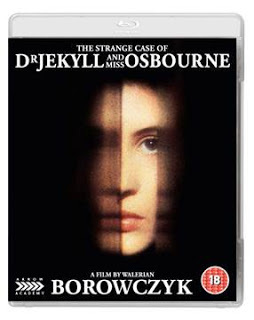
The synopsis of this film reads: 'It’s the engagement party for
brilliant young Dr Henry Jekyll (Udo Kier) and his fiancée, the
beautiful Fanny Osbourne (Marina Pierro), attended by various pillars of
Victorian
society, including the astonishing Patrick Magee in one of his final
roles. But when people are found raped and murdered outside and
ultimately inside the house, it becomes clear that a madman has broken
in to disrupt the festivities – but who is he? And why
does Dr Jekyll keep sneaking off to his laboratory?'
Why indeed? This film is one of those which can be examined in detail, the meanings and interpretations pored over ... and yet as a film, it is really not that enjoyable, mainly because it doesn't make much sense, eschewing style and interpretation over actual plot. Much of the film seems to consist of people running about an old house, along corridors, up and down stairs, and opening and closing doors. The director has a habit of focussing the camera on certain apparently unimportant elements in shot rather than actually trying to create a meaningful narrative, and so the viewer is left wondering what is going on.
When you add to this a soft porn element, such that the women are beaten and abused sexually, with the camera lingering on blood on flesh, buttocks and pubic regions, then the film starts to move from being a horror film (which perhaps it purports to be) into some other genre of voyeuristic and tacky film making.
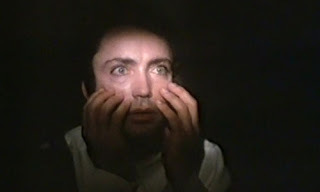
Watching the film, the plot is pretty impenetrable, and the above description is about all you can discern. There are some great characters, in particular Udo Kier as Dr Jekyll who manages to just about stay serene and above it all, and also Patrick Magee as a somewhat mad general, who bizarrely gives a sheaf of poisoned arrows, and bow, as an engagement present (lucky that these become useful later in the film to kill off most of the characters), but who also has a daughter who suddenly decides to be ravished by Mr Hyde in front of her father, and he then whips her and kills her (perhaps for her act of decadence, it's not clear).

As with most Jekyll/Hyde films, there's the transformation element, and here it is quite cumbersome. It seems that to transform into Hyde, Jekyll needs to bathe and submerge himself orgiastically in a bath of some sort of mysterious salts ... emerging as the transformed Mr Hyde (played by another actor, Gerard Zalcberg). This takes place over several minutes while Jekyll's fiancée Fanny (Marina Pierro) watches from a hiding place in the bathroom. He then heads off to indulge in a mania of destruction and killing throughout the house, until Fanny decides to transform herself, despite the fact that to change back, Hyde needs some sort of potion provided by the doctor (Howard Vernon), and there is none of this left. So she bathes in the red waters, followed by Jekyll, and then both Hyde and a contact-lensed Fanny head away from the house in a coach, ravishing each other as they go.
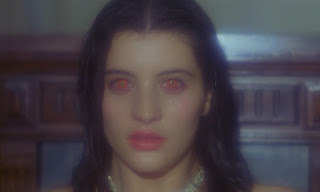
It's a strange film indeed. As I say, very hard to follow as the plot is obscure, and full of long, meaningful shots and portentous camera work. The sexual elements are not enjoyable, and sit uneasily with the horror stylings, and things seem to happen just because they can, eschewing plot and logic.
There are some aspects which I liked. The incidental music is electronic and atonal, and works to highlight the action well. Kier is very good as Jekyll as I say, and some of the camera work and lighting is very nicely handled. Overall for me, though, it's a thumbs down. Not a film I suspect I will be watching again.
As usual, Arrow have included an impressive package of extras, including two short films by the director, interviews and documentaries exploring his work.
Special Features
·
Brand new 2K restoration, scanned from the original camera negative and supervised by cinematographer Noël Véry
·
High Definition
Blu-ray (1080p) and Standard Definition DVD presentation of the film,
released on both formats for the first time anywhere in the world
·
English and French soundtracks in LPCM 1.0
·
Optional English SDH and English subtitles
·
Introduction by critic and long-term Borowczyk fan Michael Brooke
·
Audio commentary
featuring archival interviews with Walerian Borowczyk and new interviews
with cinematographer Noël Véry, editor Khadicha Bariha, assistant
Michael Levy and filmmaker Noël Simsolo,
moderated by Daniel Bird
·
Interview with Marina Pierro
·
Himorogi (2012), a short film by Marina and Alessio Pierro, made in homage to Borowczyk
·
Interview with artist and filmmaker Alessio Pierro
·
Phantasmagoria of the Interior, a video essay by Adrian Martin and Cristina Alvarez Lopez
·
Eyes That Listen, a featurette on Borowczyk’s collaborations with electro-acoustic composer Bernard Parmegiani
·
Happy Toy (1979), a short film by Borowczyk based on Charles-Émile Reynaud’s praxinoscope
·
Introduction to
Happy Toy by production assistant Sarah Mallinson
·
Returning to Return: Borowczyk and Early Cinema, a featurette by Daniel Bird
·
Reversible sleeve with artwork based on Borowczyk’s own poster design
·
Booklet with new writing on the film by Daniel Bird and archive materials, illustrated with rare stills
Published on June 03, 2015 02:21
May 31, 2015
Review - Rollerball (1975)
 Rollerball is one of those iconic films from the seventies ... something that most people have heard of, even if they haven't seen. And now Arrow Video have a lovely new remastered DVD and Blu-Ray release to remind everyone of this minor classic.
Rollerball is one of those iconic films from the seventies ... something that most people have heard of, even if they haven't seen. And now Arrow Video have a lovely new remastered DVD and Blu-Ray release to remind everyone of this minor classic.The overall plot is pretty simple. It's the future (well a future as envisaged in the 1970s, so all chrome and 'futuristic' design), and the populace enjoy an entertainment called Rollerball - in which two teams compete to score points by getting the 'Rollerball' - a silver metal sphere - into a net. But both teams are on rollerblades and ride motorbikes and circle an arena. The Rollerball is shot around the arena at speed, making it le
thal if it hits you, and anything seems to go in the game. Players can barge and attack each other, knocking them over and into the path of the ball, and fatalities are expected. However there is a deeper theme at play, one of the futility of individual effort. The game is designed to keep the populace subdued by showing that you have to work as a team to win - the individual means nothing. However, in terms of the film,James Caan is playing an individual, Jonathan, who is determined to succeed, even when corporate 'powers' want him to fail, bribing him with the return of his wife. The film ends with Caan becoming a hero, the opposite of what the corporation wanted.
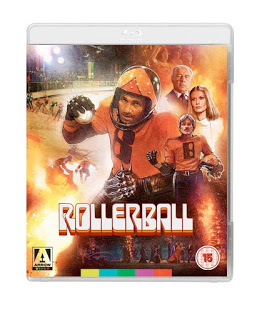 It's a very impressive film in many ways. Visually rich and splendid, the futuristic trappings are well done. It opens in a very documentary way, showing the game as though it were a sports reporting programme, with cinema veretie trappings and realism seeping from every pore. As we progress, the film starts to show its age with some incredibly slow sequences containing lots of talk. I guess these are adding the character into Caan and his struggle with the all powerful corporation, but with today's eyes, these drag the film down, and you can't wait to get back into the Rollerball ring for more action. Perhaps this was the point.
It's a very impressive film in many ways. Visually rich and splendid, the futuristic trappings are well done. It opens in a very documentary way, showing the game as though it were a sports reporting programme, with cinema veretie trappings and realism seeping from every pore. As we progress, the film starts to show its age with some incredibly slow sequences containing lots of talk. I guess these are adding the character into Caan and his struggle with the all powerful corporation, but with today's eyes, these drag the film down, and you can't wait to get back into the Rollerball ring for more action. Perhaps this was the point.The transfer and presentation of the film is excellent, with the colours rich and sharp and the picture quality brilliantly presented. Caan is superb in the lead, and it was good to spot John Hausman with his very distinctive voice as the representative of the corporation.
As with all the Arrow releases. it comes with a great selection of extras:
SPECIAL EDITION CONTENTS:
High Definition Blu-ray (1080p) presentation of the film from a digital transfer prepared by MGM Studios
Original Stereo 2.0 audio (uncompressed PCM on the Blu-ray)
Isolated Music and Effects Soundtrack
Optional English subtitles for the deaf and hard of hearing
Audio Commentary with director Norman Jewison
Audio Commentary with writer William Harrison
Blood Sports with James Caan – A brand-new interview with the Rollerball star
The Fourth City: Shooting Rollerball in Munich – Unit manager Dieter Meyer and others revisit the Audi Dome and other original locations
The Bike Work: Craig R. Baxley on the Motorcycle Stunts in Rollerball – Stunt artist Baxley on the challenges and dangers of being one of the Rollerball bikers
Return to the Arena: The Making of Rollerball
From Rome to Rollerball: The Full Circle – original EPK bringing together interviews and on-set footage
Original Theatrical Trailer
Theatrical Teaser
TV Spots
Reversible sleeve featuring original and newly commissioned artwork by Paul Shipper
Collector’s booklet featuring new writing on the film, illustrated with original archive stills and posters.
Published on May 31, 2015 04:57
May 28, 2015
The Killing (1956) / Killer's Kiss (1955) - Review
ARROW BLU-RAY,
RELEASED 9 FEBRUARY 2015
The movies
Killer’s
Kiss and The Killing were two of the very
earliest movies to be written and directed by future screen legend Stanley
Kubrick, both of them in the film noir style that was nearing the end of its
classic period by the time of their release in the mid-1950s.
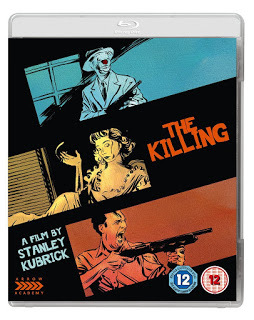
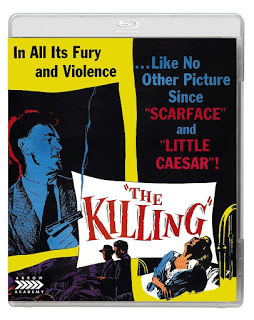
The Killing is the more acclaimed,
well-known and influential of the two productions – it was an important
touchstone for Quentin Tarantino’s Reservoir
Dogs (1992) for instance – and is presented as the main feature on this
recent Arrow Blu-ray release, with Killer’s
Kiss relegated to the status of an extra. Although Kubrick took sole on-screen
credit for The Killing’s excellent
screenplay, its dialogue was actually written by noir fiction icon Jim Thompson
(The Killer Inside Me, A Hell of a Woman, After Dark, My Sweet, The
Getaway, The Grifters etc), and it
was based on a novel, Clean Break
(1955), by another accomplished noir author, Lionel White. However, in terms of
both storyline and presentation, The
Killing has a lot in common with Robert Siodmak’s similarly-titled The Killers (1946) – the Arrow Blu-ray
release of which I guest-reviewed for this blog a few months ago – and it seems
likely that this was also a significant source of inspiration.
Like The Killers, The Killing centres around a heist plot – in this case, involving
the theft of racetrack betting money – and is told by way of a series of
out-of-sequence flashbacks, through which the viewer has to piece together the
action almost in the manner of a jigsaw puzzle. These are classic film noir ingredients
and techniques; and Kubrick reinforced the movie’s noir credentials by casting
in prominent supporting roles two of the genre’s most recognisable stalwarts –
and, as it happens, two of my favourite actors – Marie Windsor and Elisha Cook
Jnr, both arguably a little past their prime by this point. Windsor plays a
typical brassy femme fatale and Cook her milksop husband, and their bickering
interplay is, for me, one of the great highlights of this movie.
Other
earlier heist movies often said to have influenced The Killing are John Huston’s The
Asphalt Jungle (1950) and Jules Dassin’s Rififi (1955). The most obvious parallel with The Asphalt Jungle is that both movies star Sterling Hayden as the
boss of the criminal gang, giving near-identical performances in near-identical
roles; and Kubrick’s taut, documentary-style shooting of The Killing’s racetrack heist certainly recalls Rififi’s famously tense 30-minute
dialogue-free sequence depicting in almost forensic detail the carrying out of
a jewel robbery.
Often
rated as one of the greatest crime movies ever made, The Killing is one that no fan of the genre can afford to have
missing from their collection. That said, though, and at the risk of courting
considerable controversy, I have to confess that, in my eyes, Killer’s Kiss is actually the better and
more interesting of these two early Kubrick works.

Killer's Kiss
While some film
noir aficionados might consider this heresy, the advantages Killer’s Kiss has over The Killing are, for me, twofold. First,
it tells a smaller-scale, more intimate story, which is altogether more emotionally
involving than The Killing’s rather cold,
clinical approach. Likewise structured in a series of flashbacks, it tells of a
burgeoning romance between washed-up boxer Davey Gordon (Jamie Smith) and his
neighbour Gloria Price (Irene Kane), who works as a dancer in a seedy dime-a-dance
joint – a kind of more chaste 1950s equivalent of today’s lap-dancing club. The
challenge with which they have to contend is not The Killing’s logistics of planning a perfect robbery, but simply
how to avoid the attentions of Gloria’s lecherous boss Vincent Rapallo (Frank
Silvera), who is strongly implied to have raped her and has then dispatched two
thugs to murder Davey. The only false-seeming note in this gripping narrative
is its rather incongruous happy ending, and it is no great surprise to learn
that this was added in a reshoot at the behest of studio United Artists, who
stumped up the majority of the movie’s modest budget.

The Killing
The other great
merit of Killer’s Kiss is Kubrick’s fantastic
direction, which is even more gripping and inventive than
in The Killing, making brilliant use
of extensive location shooting in New York, including in the run-down streets
and alleyways of the Brooklyn waterfront and Soho areas. Some of these
sequences – such as a desperate fight between Davey and Rapallo in a warehouse
storing shop window mannequins – are incredibly striking and memorable, and
benefit from some very unusual and effective camera angles made possible by
Kubrick’s decision to dispense with on-location microphones and dub all the
dialogue and sound effects in post-production.
All in all, Killer’s Kiss is an underappreciated gem
of a movie – and one that, unlike The
Killing, is likely to be a previously undiscovered one to many of this
Blu-ray’s purchasers.
Blu-ray presentation
Arrow have again done a fine job
with this Blu-ray release. The high-definition transfers of both The Killing and Killer’s Kiss are the same ones that formed the basis of the
Connoisseur Collection’s acclaimed equivalent Region A disc, and are excellent.
There is also a strong package of added extras, including:
·
The
Evolution of a Master – critic Michel Ciment discusses Kubrick’s 1950s output;
·
An
extract from the French television series Journal
de la Cinéma featuring an interview with Sterling Hayden;
·
An
appreciation by filmmaker Ben Wheatley;
·
Theatrical
trailers for both films;
·
Collector’s
booklet containing new writing by Peter Kramer, Barry Forshaw and filmmaker Ron
Peck, illustrated with original archive stills.
Very highly recommended.
Stephen James Walker
RELEASED 9 FEBRUARY 2015
The movies
Killer’s
Kiss and The Killing were two of the very
earliest movies to be written and directed by future screen legend Stanley
Kubrick, both of them in the film noir style that was nearing the end of its
classic period by the time of their release in the mid-1950s.


The Killing is the more acclaimed,
well-known and influential of the two productions – it was an important
touchstone for Quentin Tarantino’s Reservoir
Dogs (1992) for instance – and is presented as the main feature on this
recent Arrow Blu-ray release, with Killer’s
Kiss relegated to the status of an extra. Although Kubrick took sole on-screen
credit for The Killing’s excellent
screenplay, its dialogue was actually written by noir fiction icon Jim Thompson
(The Killer Inside Me, A Hell of a Woman, After Dark, My Sweet, The
Getaway, The Grifters etc), and it
was based on a novel, Clean Break
(1955), by another accomplished noir author, Lionel White. However, in terms of
both storyline and presentation, The
Killing has a lot in common with Robert Siodmak’s similarly-titled The Killers (1946) – the Arrow Blu-ray
release of which I guest-reviewed for this blog a few months ago – and it seems
likely that this was also a significant source of inspiration.
Like The Killers, The Killing centres around a heist plot – in this case, involving
the theft of racetrack betting money – and is told by way of a series of
out-of-sequence flashbacks, through which the viewer has to piece together the
action almost in the manner of a jigsaw puzzle. These are classic film noir ingredients
and techniques; and Kubrick reinforced the movie’s noir credentials by casting
in prominent supporting roles two of the genre’s most recognisable stalwarts –
and, as it happens, two of my favourite actors – Marie Windsor and Elisha Cook
Jnr, both arguably a little past their prime by this point. Windsor plays a
typical brassy femme fatale and Cook her milksop husband, and their bickering
interplay is, for me, one of the great highlights of this movie.
Other
earlier heist movies often said to have influenced The Killing are John Huston’s The
Asphalt Jungle (1950) and Jules Dassin’s Rififi (1955). The most obvious parallel with The Asphalt Jungle is that both movies star Sterling Hayden as the
boss of the criminal gang, giving near-identical performances in near-identical
roles; and Kubrick’s taut, documentary-style shooting of The Killing’s racetrack heist certainly recalls Rififi’s famously tense 30-minute
dialogue-free sequence depicting in almost forensic detail the carrying out of
a jewel robbery.
Often
rated as one of the greatest crime movies ever made, The Killing is one that no fan of the genre can afford to have
missing from their collection. That said, though, and at the risk of courting
considerable controversy, I have to confess that, in my eyes, Killer’s Kiss is actually the better and
more interesting of these two early Kubrick works.

Killer's Kiss
While some film
noir aficionados might consider this heresy, the advantages Killer’s Kiss has over The Killing are, for me, twofold. First,
it tells a smaller-scale, more intimate story, which is altogether more emotionally
involving than The Killing’s rather cold,
clinical approach. Likewise structured in a series of flashbacks, it tells of a
burgeoning romance between washed-up boxer Davey Gordon (Jamie Smith) and his
neighbour Gloria Price (Irene Kane), who works as a dancer in a seedy dime-a-dance
joint – a kind of more chaste 1950s equivalent of today’s lap-dancing club. The
challenge with which they have to contend is not The Killing’s logistics of planning a perfect robbery, but simply
how to avoid the attentions of Gloria’s lecherous boss Vincent Rapallo (Frank
Silvera), who is strongly implied to have raped her and has then dispatched two
thugs to murder Davey. The only false-seeming note in this gripping narrative
is its rather incongruous happy ending, and it is no great surprise to learn
that this was added in a reshoot at the behest of studio United Artists, who
stumped up the majority of the movie’s modest budget.

The Killing
The other great
merit of Killer’s Kiss is Kubrick’s fantastic
direction, which is even more gripping and inventive than
in The Killing, making brilliant use
of extensive location shooting in New York, including in the run-down streets
and alleyways of the Brooklyn waterfront and Soho areas. Some of these
sequences – such as a desperate fight between Davey and Rapallo in a warehouse
storing shop window mannequins – are incredibly striking and memorable, and
benefit from some very unusual and effective camera angles made possible by
Kubrick’s decision to dispense with on-location microphones and dub all the
dialogue and sound effects in post-production.
All in all, Killer’s Kiss is an underappreciated gem
of a movie – and one that, unlike The
Killing, is likely to be a previously undiscovered one to many of this
Blu-ray’s purchasers.
Blu-ray presentation
Arrow have again done a fine job
with this Blu-ray release. The high-definition transfers of both The Killing and Killer’s Kiss are the same ones that formed the basis of the
Connoisseur Collection’s acclaimed equivalent Region A disc, and are excellent.
There is also a strong package of added extras, including:
·
The
Evolution of a Master – critic Michel Ciment discusses Kubrick’s 1950s output;
·
An
extract from the French television series Journal
de la Cinéma featuring an interview with Sterling Hayden;
·
An
appreciation by filmmaker Ben Wheatley;
·
Theatrical
trailers for both films;
·
Collector’s
booklet containing new writing by Peter Kramer, Barry Forshaw and filmmaker Ron
Peck, illustrated with original archive stills.
Very highly recommended.
Stephen James Walker
Published on May 28, 2015 04:30
February 27, 2015
Review - Rabid (1977)

I have a fond association with David Cronenberg's second major film, Rabid. It was one of the earliest film novelisations that I ever read, and I may have even read the novelisation before I saw the film ... and I remember a local cinema down in Newquay, Cornwall, had the poster in their frame showing the girl in the deep freeze ... and this image tantalised and thrilled me ... it wasn't until I saw the actual film that I understood who the girl was and why she was frozen!
And now the lovely people at Arrow have released a remastered version of the film on Blu-Ray, complete with a nice little selection of extras ... so let's dive in! But be warned, on this occasion I do give away the ending ... so if you've not seen it and intend to, then stop reading now.
The film itself looks lovely. There is some black speckling around the opening title cards, but I suspect that this is on the original prints too, and would perhaps take too much to remove digitally. But aside from this, the print looks clean and is very watchable. The film itself is actually a little pedestrian to be honest, but it has a seventies charm about it. It's interesting to note that it was released the same year as another favourite film, Dario Argent's Suspiria as both films seem slightly ahead of their time. Cronenberg always comes up with the goods, and here it is former porn actress Marilyn Chambers who astonishes as Rose, a biker-chick girl who gets into a nasty motorcycle accident outside a place called the Keloid Clinic near Montreal (after Doctor Keloid, and not after the keloid as a type of scar tissue - though the medical meaning of the word is obviously deliberate in the context of the film). Rose is taken into the Clinic and given emergency treatment and plastic surgery to repair damage to her breasts and hpper body - flesh is removed from her thighs and treated to transform it into generic tissue which can then take on the attributes of wherever it is used on the body.

Unfortunately for Doctor Keloid and Rose, some of this generic tissue decides to develop into a puckered anus-like lesion under Rose's arm, and inside the hole is a chitinous barb, through which Rose can ingest blood from victims. Thus Rose heads off on a bloodsucking spree, taking from patients and nurses at the surgery. Unfortunately, these people then develop a fast-spreading madness, similar to rabies (hence the title of the film) and before long, Montreal is under martial law as people head off foaming at the mouth, biting others, and spreading the 'zombie plague'.

The film meanders a little, but always comes back to Rose, who ends up living with a friend ...but Rose gets sick when she doesn't eat, and she doesn't want to feed off her friend ... but then ends up killing her anyway ... she has a fight with her boyfriend who wants to help ... but Rose is an independent sort, and doesn't believe that she is the source of the infection, so she picks up another man and feeds from him, locking herself in a room with him to prove that he won't go mad ... but of course he does and the film ends on a somewhat bleak note, with Rose's body being thrown in a dump truck with the rubbish.
As a cycle, it's quite neat, as the ending removes the source of infection, and, presumably, all the other crazies will be hunted down and killed, and the problem is resolved. But for Rose, as an innocent and helpless victim, it's bleak and unremitting. She has been turned into a quasi-vampire by doctors, and can't help her hunger for blood - when she tries to resist it, and even to eat normal food, her body can't process it and she's sick and vomiting, or writhing on the floor clutching her stomach in intense pain. She HAS to feed to survive, but that feeding spreads the madness. She even tries feeding from a cow, but this too fails - she can take only human blood.

So in this sense, the film is very tightly constructed, and Rose's trajectory really only has one arc, and can really only end in one way.
Also on the disk among the extras is an episode of The Directors series which focusses on Cronenberg, covering off all his films, and revealing that, in actuality, The Fly is his most commercially successful film to date. It also reveals that Cronenberg has had to withdraw from projects because of studio interference, and that he feels he has to remain true to his own visions in his filmmaking, and, to be honest, this is why his oevre is so intense and personal, and has resulted in works as diverse and surreal as Shivers, The Brood, Scanners and eXistenZ, not to mention Crash and Naked Lunch.
The film was released in a dual formal Blu-Ray and DVD format by Arrow on February 16th 2015.
All in all, it's a great little package, showcasing a good slice of early eighties horror from a director who always makes films which are thoughtful and entertaining, never forgetting that at the heart of any good horror story, there is a personal viewpoint.

SPECIAL EDITION CONTENTS:
New High Definition Digital Transfer
High Definition Blu-ray (1080p) and Standard Definition DVD presentation of the feature
Original mono audio (uncompressed PCM on the Blu-ray)
Optional English subtitles for the deaf and hard of hearing
Audio Commentary with writer-director David Cronenberg
Audio Commentary with William Beard, author of The Artist as Monster: The Cinema of David Cronenberg
Archive interview with David Cronenberg
Brand new interview with executive producer Ivan Reitman
Brand new interview with co-producer Don Carmody
Make-up Memories: Joe Blasco Remembers Rabid – A short featurette in which Blasco recalls how the film’s various gruesome effects were achieved
Raw, Rough and Rabid: The Lacerating Legacy of Cinépix – Featurette looking back at the early years of the celebrated Canadian production company, including interviews with author Kier-La Janisse and special makeup artist Joe Blasco
The Directors: David Cronenberg – A 1999 documentary on the filmmaker, containing interviews with Cronenberg, Marilyn Chambers, Deborah Harry, Michael Ironside, Peter Weller and others
Original Theatrical Trailer
Reversible sleeve featuring original and newly commissioned artwork by Nat Marsh
Collector’s Booklet featuring new writing on the film by Kier-La Janisse, reprinted excerpts of Cronenberg on Cronenberg and more, illustrated with original archive stills and posters.
Published on February 27, 2015 04:57
February 23, 2015
Out of the Unknown

I never saw any of Out of the Unknown, the BBC's somewhat trailblazing science fiction anthology series when it was first transmitted. It started in 1965 and presented a series of one-off plays, all with a science fiction theme, and written by some of the great writers of the time. Thus there is material by John Wyndham, Isaac Asimov, William Tenn, Frederick Pohl and John Brunner all being adapted by playwrites like Stanley Miller, Jeremy Paul, Paul Erikson and J B Priestly ... such a thing does not exist on television these days, with all genre shows being series based and written by a small cabal of writers. But these are marvellous and magnificent achievements.
For a Doctor Who fan like myself, the delight is also in spotting the re-use of sound effects and music, plus many of the same actors as from the good Doctor's adventures ... and perhaps the best example of this in this set is the 1969 episode 'The Last Lonely Man' which is directed by Douglas Camfield, stars Peter Halliday, and has music by Don Harper - all the same as the Doctor Who story 'The Invasion' from 1968. A treat indeed.
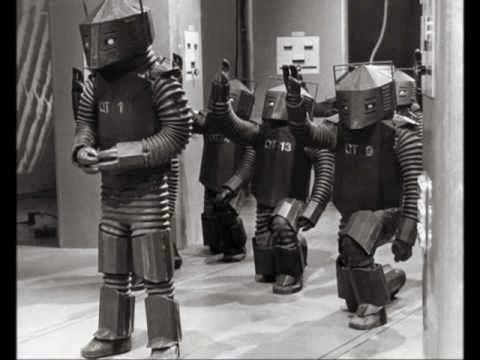
Robots from 'The Prophet' which were later used in the
Doctor Who story 'The Mind Robber'.
This boxed set, produced by the BFI, is both a work of great passion, and at the same time, great disappointment. As was typical with BBC shows of the time, a great many of them have been wiped and destroyed, and thus we have a fairly limited selection to enjoy today. The four seasons break down as follows in terms of what exists and what has been destroyed:
SEASON 1 - 10 Exist; 2 Destroyed
SEASON 2 - 4 Exist; 9 Destroyed
SEASON 3 - 1 Exists; 12 Destroyed
SEASON 4 - 5 Exist; 6 Destroyed
As you can see, it's a depressing showing. But the DVD release makes the most of what material does exist, with it being cleaned up and remastered. There are also several 'reconstructions', using the original soundtracks matched to stills from the episodes, but these make for hard viewing. A better approach is the one used for 'The Uninvited' where the soundtrack is matched with the camera script so you can read what is happening on screen. This one seems easier to follow than the others and could simply be down to a better quality soundtrack - some of the others are a little 'muddy'.

'The Machine Stops' one of the more famous episodes.
It is a shame though that seasons 3 and 4 are so underrepresented as the series underwent a major shift in direction with the move to colour. This coincided with creator Irene Shubik moving off and Alan Bromly taking over, and I'm not sure I like the results. Wheras the black and white science fiction of series 1 and 2 was all alien worlds, spacecraft, strange blonde young men, futuristic ideas and concepts and great effects and visualisation in studio, the colour series 4 episodes tend towards present day location work, and psychological dramas, household terrors and more mundane horrors. In fact the final season is closer to Roald Dahl's Tales of the Unexpected and the Hammer House of Horror series than to anything science fiction or 'unknown' - but again this might be more because of what remains to be viewed than what the series was actually trying to achieve as a whole.
The comprehensive booklet of notes explains that Shubik was taken off after Series 2, but that she had commissioned all the scripts for Series 3 before her departure, and that it was Series 4 which had a darker more psychological remit. This seems to tally as the sole series 3 episode ('The Last Lonely Man') is one of the most enjoyable episodes on the collection, while the Series 4 episodes all seem strangely downbeat and samey.

George Cole and Peter Halliday in 'The Last Lonely Man'.
Whatever observations might be made of the content, the presentation of this set is brilliant. The episodes have been remastered and for the most part cleaned up and improved. There are reconstructions of several missing episodes, and party of one missing episode is included ('The Little Black Bag', half of which was found on an Engineering Training tape at BBC Glasgow!). There is a special documentary which interviews many surviving cast and crew members, and which also contains footage from other missing episodes, some of which have been colour-recovered. There are commentaries on many of the episodes too, and extensive stills galleries, so we can marvel and wonder at just what the lost episodes might have been like ... Just about every surviving element of Out of the Unknown is contained on the disk ... it's a labour of love for those involved in compiling it.
For fans of vintage television, and especially of the science fiction and horror genres, this is a must-have purchase. Enjoyable and thought provoking, even today, Out of the Unknown stands the test of time. It's just such a shame that so much has been lost.

The aliens from 'Beach Head' one of the missing episodes.
Published on February 23, 2015 08:13
February 20, 2015
The Bradbury Building
Following on from my last blog about The Outer Limits, one of my favourite episodes from that show, and possibly my favourite slice of sixties television, is 'Demon with a Glass Hand'. Scripted by Harlan Ellison from his own story, it tells the tale of Trent, a man who holds the future of Humanity but he can't remember how or why. He has been sent back in time to avoid the alien Kyben, but they follow him through a time mirror. One of his hands has been replaced by a computer, and this advises him to locate the remaining fingers of his hand so that it can help him better. He is trapped in an old office building, and therein meets a girl. And together they have to avoid the Kyben, repair his hand, and save Humanity.
It's a brilliant idea, and it is executed perfectly. The cinematography is brilliant: the black and white photography perfectly capturing the story, and the use of light and dark and shadow is also masterful. Everything about the teleplay is, to my mind, perfect, and one of the main elements which works so well is the office building, an art deco monstrosity of walkways, railings and stairs, with metal lifts and bags of personality.
The building has been used several times in film and television. The most well known usage was in the film Blade Runner where it is used for where J F Sebastian has his robot/doll making shop. It was also used in The Artist and many, many more.
Amazingly, it still exists in Downtown LA (304 Broadway at West 3rd Street) and is called The Bradbury Building - not after the famous science fiction writer, but after it's funder Lewis L Bradbury. When we visited LA this year, we met with our friend Dean Haglund, who lives on Broadway, and he kindly took us down to the Bradbury for a look.
It was built in 1893 and more information about the building and it's history and use in film and television can be found on the Wiki entry here: http://en.wikipedia.org/wiki/Bradbury...
Unfortunately, while you can freely visit the lobby and lower stairs, all the upper floors and walkways are out of bounds as the building is currently being used by the LAPD's Internal Affairs division ... but you can still see them. The lifts are still there, the railings, the walkways, and it all looks the same as on that Outer Limits episode. Here's a pile of black and white photographs from the episode and my own colour shots taken this year ... it's a magnificent piece of architecture, beautiful and imposing, and I am so glad that it hasn't been torn down or changed to make way for some modernist mall or office block.
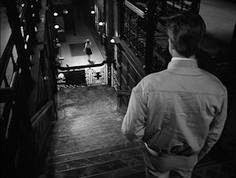
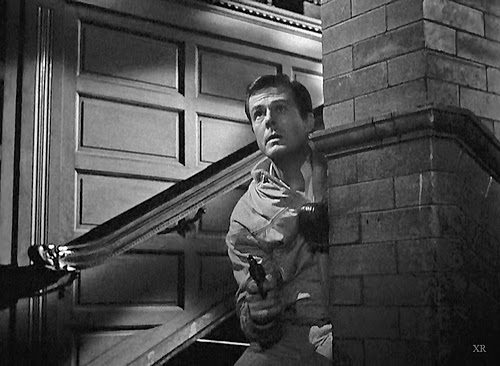
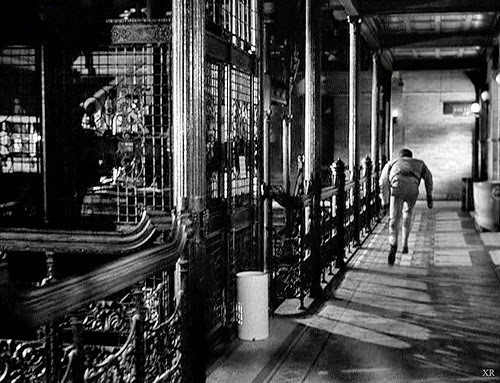












It's a brilliant idea, and it is executed perfectly. The cinematography is brilliant: the black and white photography perfectly capturing the story, and the use of light and dark and shadow is also masterful. Everything about the teleplay is, to my mind, perfect, and one of the main elements which works so well is the office building, an art deco monstrosity of walkways, railings and stairs, with metal lifts and bags of personality.
The building has been used several times in film and television. The most well known usage was in the film Blade Runner where it is used for where J F Sebastian has his robot/doll making shop. It was also used in The Artist and many, many more.
Amazingly, it still exists in Downtown LA (304 Broadway at West 3rd Street) and is called The Bradbury Building - not after the famous science fiction writer, but after it's funder Lewis L Bradbury. When we visited LA this year, we met with our friend Dean Haglund, who lives on Broadway, and he kindly took us down to the Bradbury for a look.
It was built in 1893 and more information about the building and it's history and use in film and television can be found on the Wiki entry here: http://en.wikipedia.org/wiki/Bradbury...
Unfortunately, while you can freely visit the lobby and lower stairs, all the upper floors and walkways are out of bounds as the building is currently being used by the LAPD's Internal Affairs division ... but you can still see them. The lifts are still there, the railings, the walkways, and it all looks the same as on that Outer Limits episode. Here's a pile of black and white photographs from the episode and my own colour shots taken this year ... it's a magnificent piece of architecture, beautiful and imposing, and I am so glad that it hasn't been torn down or changed to make way for some modernist mall or office block.















Published on February 20, 2015 04:32
January 31, 2015
The Outer Limits at 50

A selection of the Outer Limits trading cards.
When I was a young lad, we used to buy sweets from the local newsagents ... and I remember than among the delights to be found were things called 'Lucky Bags' which contained some candy, a strip of gum (I think) a small toy (no recollection of what) and a packet of trading cards. Most of the shops around Tolworth in South London where I grew up didn't have these, but there was one shop over in Hook which did ... and the trading card packets were for some show called The Outer Limits. Now I'd never heard of this show ... but I loved (and still do) things like Lost in Space and Doctor Who, and from the images on these cards, it seemed that The Outer Limits was of a similar ilk.
I never managed to collect a full set of the cards. They were only in the lucky bags, and these were hard to find, so I only ended up with a handful of cards. I have no idea where they are now! Lost somewhere in a room clearance in the distant past ... strange for me as I do have preserved all manner of things from my childhood. But not these.

A few years later, I got into horror magazines. I had a paper round and the local newsagent had one of those carousel magazine racks, and in it were occasional copies of Famous Monsters of Filmland, Monster Mag, and later House of Hammer ... as well as several other American imported magazines. All of which I devoured. It must have been in one of these that I first came across something called TOLAIR - The Outer Limits: An Illustrated Review. Not knowing much about anything, I ordered it, and when it arrived I was blown away - the photos, the details ... this was a series that I just had to try and see! And this was Volume 2 ... and no way to get Volume 1! But how? It was American, black and white, and there were no videos or DVDs, or even Internet in these backwards days ... I remember seeing that someone was talking in a letter about the music and about how amazing this show was aurally ... and I was just getting more and more frustrated.
And then. BBC2 ... Bless you BBC2 ... they showed the entire series ... late night ... but I was totally hooked. I'm not sure what year it was, but it must have been early 80s as I video recorded every episode (and we got our first video machine in 1979). I totally fell in love with the series.

As the correspondent had mentioned, aurally it was a delight. The music was unique and creepy and totally drew you in. The sound effects, the monsters every week ... it was far superior to Lost In Space, and the episode 'Demon with a Glass Hand' is one of my favourite things ever!
And last year (2014), The Outer Limits turned 50 years old ... it must have started in 1964, the year after Doctor Who started. And to mark the occasion, David J Schow (a writer for whom I have long held a fond respect for as his name differs from mine in just the spelling of his second name - hey we even rhyme!) released a book celebrating the series. And it's magnificent.
David holds the series in the same kind of regard as I do Doctor Who, and like me, has accumulated a vast archive of Outer Limits ephemera. And this book brings much of it together. There are rare photos from the episodes, remembrances, strange facts, model kits and jigsaws, newspaper cuttings and much more ... this is actually very much like my own book Timeframe for Doctor Who ... a love letter to the show ... And I adore it!
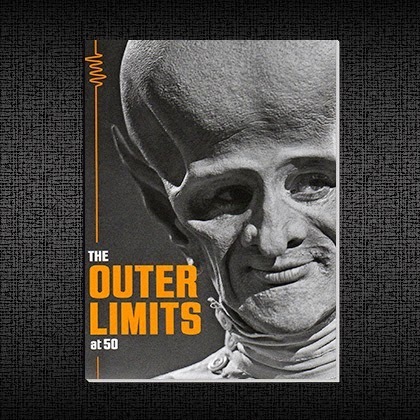
If you have an interest in classic television, and in particular genre television, then this book, and David's earlier work The Outer Limits Companion, are essential for your bookshelf. I can't rave about them enough.
What we need now, is some nice DVD company to release a proper, cleaned up and remastered box set of all the episodes, including all the available extras (there is a great list of some of the things that could be included in this very book!) The Outer Limits is a series which deserves some love and care and a pristine Blu-Ray release ...
The book The Outer Limits at 50 can be bought here: http://creaturefeatures.com/shop/book...
Published on January 31, 2015 09:19
January 24, 2015
Thief (1981) - Review

Michael Mann is one of those names which is spoken of in hushed tones. As a director, his films are feted and admired. Thief, made in 1981, was his first cinema film. According to IMDB, before this, he had only directed a few shorts, an episode of a TV series, and a TV Movie. And it's certainly an impressive debut. Mann would go on to direct The Keep (1983) and Manhunter (1986), not to mention The Last of the Mohicans (1992) ... so there is something of a pedigree here. Unfortunately Thief sees Mann coming to grips with all the elements which he would later excel at. While the visual element of the film is exemplary, with some simply beautiful shots of rain-soaked streets and a neon-washed Chicago, the narrative structure is slow and hard to get to grips with. The film has been constructed in an almost cinema veritie style, with the actors speaking and behaving as in real life, rather than as perhaps a film might present them, and this further obscures what is actually happening.

The plot follows the titular Thief, Frank (James Caan), who is working as a car salesman, while doing a bit of diamond-robbing on the side. The opening section is magnificent. With a pounding soundtrack courtesy of Tangerine Dream (who Mann would go on to work with again on The Keep) which reminded me a lot of the way that director Dario Argento used the music by Goblin in his seminal horror film Suspiria (1979), Frank expertly drills into a safe and extracts the diamonds within. There is no dialogue at all, the action being carried by the music and visuals. Following this, we then get to know a little about Frank, and James Caan is excellent in the role. His is a complex character, driven by forces which the viewer doesn't really get to understand. Indeed, the film is more about relationships than action, and there are long dialogue scenes which unfortunately tend to drag things down.
Frank agrees to spring a friend, Okla (Willie Nelson) out of prison, and becomes embroiled with another gang boss, Leo (Robert Prosky), to steal another load of diamonds from another vault. Crime being what it is, the whole thing doesn't end well for anyone! Along the way Frank picks up a girlfriend, Jessie (Tuesday Weld), and there's lots of car chases and tremendous visuals, and even John Belushi in his first major film role. All the time the Tangerine Dream soundtrack lifts and underpins the action, and in places it has a very Blade Runner feel to it ... which the rain and visuals help to emphasise. Towards the end of the film there are several explosions, which have to be some of the best ever committed to film. Very impressively executed and edited.

Overall, Thief is an impressive film, but it does take a little work for the viewer to fully access. This might simply be a factor related to the time the film was made ... almost straddling the decade between earlier films which were dialogue-based, and later fare which pushed the action to the forefront. Certainly with the visual element, the film benefits greatly from release on Blu-Ray.
On the extras front, there's an impressive number of items:
Limited Slipcase Edition [3000 units] featuring two versions of the film
High Definition Blu-ray (1080p) presentation of the director’s cut from a new 4K film transfer, approved by director Michael Mann, with uncompressed 5.1 DTS-HD Master Audio
High Definition Blu-ray (1080p) presentation of the original theatrical cut [Limited Edition Exclusive] with original uncompressed 2.0 Stereo PCM audio
Optional English subtitles for the deaf and hard of hearing
Optional isolated music and effects track on the theatrical cut
Audio commentary by writer-director Michael Mann and actor James Caan
The Directors: Michael Mann – a 2001 documentary on the filmmaker, containing interviews with Mann, James Belushi, William Petersen, Jon Voight and others
Stolen Dreams – a new interview with Caan, filmed exclusively for this release
Hollywood USA: James Caan – an episode of the French TV series Ciné regards devoted to the actor, filmed shortly after Thief had finished production
The Art of the Heist – an examination of Thief with writer and critic F.X. Feeney, author of the Taschen volume on Michael Mann
Theatrical trailer
Reversible sleeve featuring original and newly commissioned artwork by maarko phntm
Illustrated collector’s booklet featuring new writing on the film by Brad Stevens
Overall, it's a good, solid release, and fans of the genre, of Caan, and of Mann's work are well served. Now ... what we really need is a Blu-Ray release of The Keep ...

Thief is released 2 Feb 1015 by Arrow Films.
Published on January 24, 2015 08:57
January 12, 2015
Review: The Quiet Ones (2014)

Back in the day, Hammer Films was an institution, creating a whole raft of horror films (and some others - psychological thrillers and bawdy comedies, mainly) which captured the public imagination and made stars of Peter Cushing, Christopher Lee, Ralph Bates and many others. From my perspective, the films worked as although they were low budget, they made impressive use of Bray House and its surrounding forests and land, and used a company of actors who could be relied upon to deliver. Even the fact that they were very formulaic worked in their favour (how many innkeepers did Michael Ripper play, exactly?*).
Over the years, Hammer fell into the doldrums, and was then bought by enterprising folk who decided to try and revive the film brand ... and THE QUIET ONES is the latest effort from them. What I don't quite understand, though, is why all the things that made the Hammer brand great in the sixties and early seventies are now missing: there's no company of actors involved, no use of the strangely period-free period setting, no mid-European villages which might have been Germanic or Romanian or somewhere like that (of course unspecified), and no strong development of the themes and characters with which they made their name (like Dracula or Frankenstein and his monster, or the Mummy and so on). Instead we get fairly run of the mill psychological dramas, which owe more to the original Hammer thrillers than to their horror fare.
THE QUIET ONES is about a troubled university professor, Joseph Coupland (well played by Jared Harris, who is the best thing about the film) who believes that a young girl, Jane Harper (Olivia Cooke) is possessed by some evil demonic entity. So he keeps her locked up and gets a group of students - Brian (Sam Claflin), Krissi (Erin Richards) and Harry (Rory Fleck-Byrne), to help him observe and record the entity. However the university cuts his funding and so they all move to a spooky house (how they pay for this is unsure) to continue their 'work'. Of course it all ends badly, and the demon is identified and people start dying ...
 Creating a new twist on the found footage and paranormal activity genres can be hard, but I liked the underlying ideas here. Good to see Tom deVille, who I know from his days writing the excellent URBAN GOTHIC, as the original screenplay writer here (and he's interviewed on the extras) but less impressed that more writers (Craig Rosenberg and Oren Moverman) worked on it, and also that the director, John Pogue, is co-credited for the screenplay. It is also said in the making-of documentary that Jared Harris re-wrote his character as well ... and you wonder whether the vision of the original writer was really preserved. I guess that's filmmaking for you ... and no wonder then that the screenplay is a little ragged as a result. There's a whole sexual element which seemed to sit poorly with the horror element - Coupland is having a relationship with Krissi, who is also sleeping with Harry, and Coupland also seems to be also in love with Jane, who is also attracted to Brian, while Brian is attracted to Jane ... all very complicated, and as Jane looks about sixteen, it adds a slightly bad taste to the whole thing.
Creating a new twist on the found footage and paranormal activity genres can be hard, but I liked the underlying ideas here. Good to see Tom deVille, who I know from his days writing the excellent URBAN GOTHIC, as the original screenplay writer here (and he's interviewed on the extras) but less impressed that more writers (Craig Rosenberg and Oren Moverman) worked on it, and also that the director, John Pogue, is co-credited for the screenplay. It is also said in the making-of documentary that Jared Harris re-wrote his character as well ... and you wonder whether the vision of the original writer was really preserved. I guess that's filmmaking for you ... and no wonder then that the screenplay is a little ragged as a result. There's a whole sexual element which seemed to sit poorly with the horror element - Coupland is having a relationship with Krissi, who is also sleeping with Harry, and Coupland also seems to be also in love with Jane, who is also attracted to Brian, while Brian is attracted to Jane ... all very complicated, and as Jane looks about sixteen, it adds a slightly bad taste to the whole thing.And don't get me started on the shakeycam. Unfortunately I suffer from slight motion sickness, and these films, with the camera jerking all over the place, are just unwatchable for me. I can't follow the action, and the jerking and movement robs the film of any dramatic tension. Thankfully, the jerkycam sequences are not that frequent here - they come with the conceit that Brian has been asked to film the tests on Jane ... and so he carries his camera about, and we see through its lens at certain points in the action.

As to why it is called THE QUIET ONES ... this term is used once in the film, in relation to Coupland's group of students ... and seems to have no bearing on the demon or anything else that the film is about ... a strange title to use. Especially as the film relies on loud bursts of noise to create scare 'jumps', and is peppered with seventies pop music to ram it's period setting down the audiences' throat!
Overall, the film falls into the 'paranormal' section of viewing, one which has been somewhat overdone of late. It's an adequate example, and aside from Harris' great performance, is very forgettable. I feel it's a great shame that it has a modern (well, 1970s) setting, as if you took the same plot and idea, and instead, based it in Karlsbadt, with maybe Harris as Father Sandor investigating the case of demon possession, then you have something new and original to add to the classic Hammer oevre ... instead of which we have this rather sub-par offering.
Published on January 12, 2015 07:07



